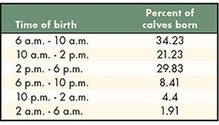A case for evening feeding |
| By Lauren Peterson |
|
|
|
The author is a senior at Kansas State University and was the 2017 Hay & Forage Grower summer intern. With rising market prices for live calves, staying up all night to supervise first-calf heifers during calving season is well worth the effort to many producers. A recent Oklahoma State University Cow/Calf Corner newsletter notes that while supervision at calving does significantly cut calf mortality, it is often less effective in the middle of the night. “The easiest and most practical method of inhibiting nighttime calving at present is by feeding cows at night; the physiological mechanism is unknown, but some hormonal effect may be involved,” says Oklahoma State University Emeritus Extension Animal Scientist Glenn Selk. Studies on rumen motility have shown a decline in rumen contractions within hours of parturition. Selk explains that intraruminal pressure falls the last two weeks of gestation, with a rapid drop during calving. By feeding at night, it’s thought that intraruminal pressures are more apt to rise at night and decline in the daytime. Dubbed the Konefal method after Canadian rancher Gus Konefal’s observations in the 1970s, this concept has spawned a number of studies. Selk discusses a Canadian follow-up study on 104 Hereford cows. Of the group fed at 8 a.m. and 3 p.m., 38.4 percent delivered calves during the day, compared to 79.6 percent daytime births from cows fed at 11 a.m. and 9 p.m. A more substantial study was conducted on 1,331 cows across 15 Iowa farms. Fed once daily at dusk, 85 percent of the calves were born between 6 a.m. and 6 p.m.  “It is interesting to note that 85.28 percent of the calves were born between 6 a.m. and 6 p.m.,” Selk says. “This is very similar to Iowa data when cows were fed at dusk.” The data also revealed that most of the herd typically calved within three hours of their times from previous years. Selk concludes that feeding forage in the early evening undoubtedly influenced the number of cows calving in the daylight hours. “Records here at Oklahoma State University indicated that when cows had constant access to large round bales but were fed supplements at about 5 p.m., 70 percent of the calves were delivered between 6 a.m. and 6 p.m.,” Selk adds. For operations that offer this round-the-clock feeding, Selk suggests putting round bales and ring feeders inside a fenced enclosure. Producers can then provide access at dusk and throughout the evening before moving them to an adjacent pasture the following morning. “Anecdotal reports have indicated that this method has the desired results with a higher percentage of calves born in the daylight,” Selk states. This article appeared in the February 2018 issue of Hay & Forage Grower on page 23 Not a subscriber? Click to get the print magazine |
